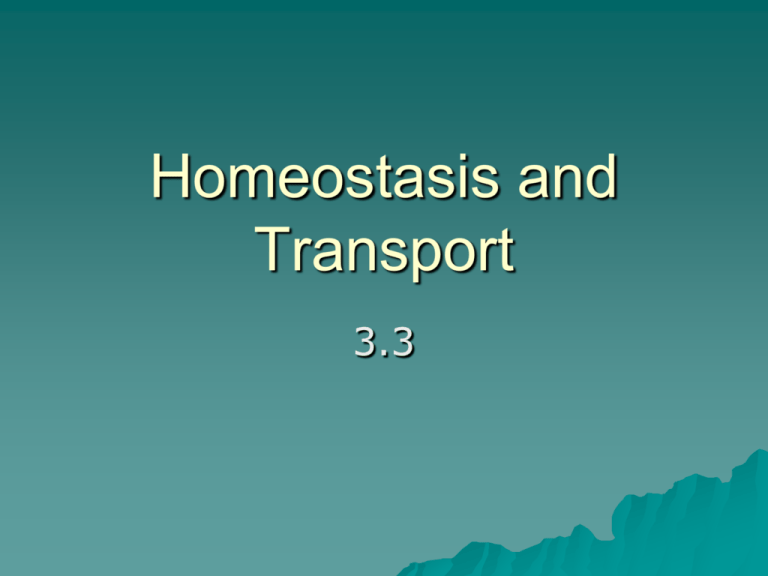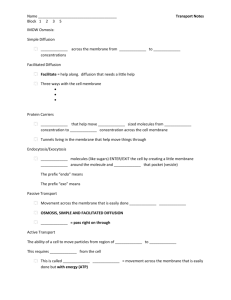Homeostasis and Transport
advertisement

Homeostasis and Transport 3.3 Passive Transport the movement of substances across a cell membrane without the use of cell energy. Types of Passive Transport Diffusion Osmosis Facilitated Diffusion Diffusion through Ion Channels 1. Diffusion the movement of molecules from an area of higher concentration to an area of lower concentration. This difference in the concentration of molecules across a space is called a concentration gradient. Molecules move from areas where they are more concentrated to areas where they are less concentrated. 2. Osmosis the process by which water molecules diffuse across a cell membrane from an area of higher concentration to an area lower concentration. Types of Solutions Hypotonic – describing a solution whose solute concentration is lower than that inside the cell. Hypertonic – describing a solution whose solute concentration is higher than that inside the cell. Isotonic - describing a solution whose solute concentration equals that inside a cell. Results of Osmosis Turgor pressure – the pressure that water molecules exert against the cell wall. Plasmolysis – the shrinking or wilting of a cell from the cell wall in a hypertonic environment. Turgor pressure is lost. (Ex: wilting in plants.) 3. Facilitated Diffusion another used type of passive transport for molecules that cannot diffuse rapidly. Molecules are assisted by carrier proteins. Steps in Facilitated Diffusion 1. A carrier protein binds to a molecule on one side of the cell membrane. 2. The carrier protein changes shape, shielding the molecule from the interior of the membrane. 3. The molecule is released on the other side of the membrane. 4. Diffusion through Carrier Molecules a membrane protein provides a passageway across the cell membrane through which an ion can diffuse. Active Transport the movement of a substance across a cell membrane against a concentration gradient; requires the cell to expend energy (ATP). Sodium-Potassium Pump a carrier protein that actively transports K+ ions into and Na+ ions out of the cell. Endocytosis the process by which cells ingest external fluid, macromolecules and large particles, including other cells, by surrounding and engulfing the substances. Types of Endocytosis Pinocytosis – engulfing of solutes or fluids. Phagocytosis – engulfing of large particles or whole cells. – Phagocyte – a cell that engages in phagocytosis. Exocytosis a process in which a vesicle inside a cell fuses with the cell membrane and releases its contents to the external environment.








